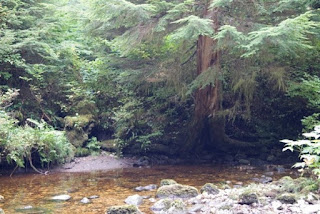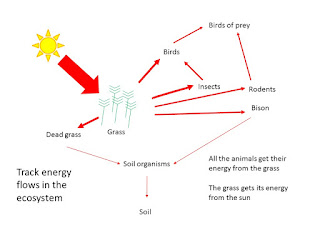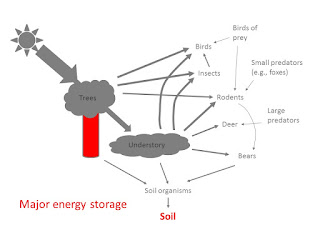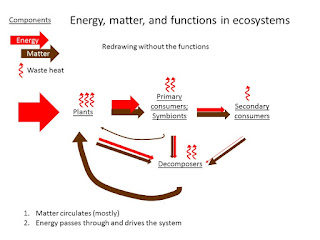It lays out the parts of how ecosystems work that will be useful in understanding how an economy works.
CHAPTER 2: ECOSYSTEMS - FLOWS OF ENERGY AND MATTER
The previous chapter made the case for an economy having some important similarities to an ecosystem, and for resources and the environment playing a fundamental role in macroeconomics.
Every economic process uses resources in one way or another, and economic change can even be defined as a change in the way resources are used.
The next step is to study how ecosystems work. This may seem like an odd move in an economics course, but there are two reasons for doing it.
The first is that ecosystems are in some ways simpler than economies. The extra complications of economies have to do with the social tools humans create, which we’ll start getting into in chapter 6. But their role will be easier to understand if we start without them.
The other consideration is that there’s a long history of people studying ecosystems as ecosystems, and not so much of looking at economies that way, so we’re going to poach off of knowledge gained in other fields.
Chapter overview
- 1st and 2nd Laws of Thermodynamics
- Energy storage and gradients
- Functions and structures in ecosystems
- Circulation of matter vs. pass-through of energy
Start by looking at a classic American landscape, the prairie. The attention grabber, the guy with the big charisma, is the bison.
 |
| http://www.springcreekforest.org/images/Buffalo-prairie-web2.jpg |
 |
| http://www.fromdakota.com/Animals/animals.html |
And we can track the energy flow between them, which is that the bison eat the grass—energy contained in the grass flows to the bison.
Then we can start adding other things that eat the grass (or that eat different plants, though grass is the dominant one).
And we can add relationships where animals eat animals.
Not all the grass gets eaten alive. Some of it dies of other causes and falls to the ground, where it becomes food for soil organisms that decompose it and turn it into richer soil.
The soil organisms also finish off the job of decomposing animals’ droppings, and their carcasses when they die.
So indirectly, a worm making its way through the soil is using energy that was originally brought into the ecosystem by the plants up above.
But of course the plants didn’t create that energy—they merely made it available to the rest of the ecosystem, by capturing sunlight.
It can all be summarized in this diagram, with red arrows indicating flows of energy.
These energy relationships are the first big thing to observe about the prairie. The second has to do with energy that one animal consumes but that doesn’t make it into someone else’s mouth.
An insect feeding on the grass contains energy—that’s a major part of why a bird wants to eat it.
But when that insect gets some energy from the grass, it doesn’t just store it. It uses a lot of it to operate its metabolism: moving its blood, flapping its wings, maintaining its body. When it’s young it uses energy to grow, moving into place all the molecules that make up its expanding body.
The energy an organism uses on its metabolism isn’t available in its body to be consumed by the next predator. Instead, that energy leaves the ecosystem as waste heat, heat that is given off into the surrounding environment and soon becomes thoroughly mixed in with that environment, unavailable for the accomplishment of any useful task.
This modification of the previous diagram shows the dissipation of energy as waste heat.
Energy storage and gradients
In addition, to being moved around, energy is stored in various places. Every organism represents storage on some scale. On a prairie, grass is a big one. Depending on weather conditions, dead plants can accumulate on the ground, an energy storage that is sometimes spectacularly released in a prairie fire. And the deep prairie soil is the result of millennia of small additions, dead matter being decomposed but its energy not fully released.
This representation of the prairie ecosystem has been pretty simplified, but we can still use it to illustrate a pair of principles that are crucial, not just for how ecosystems work, but for economies as well.
Note that all the solar energy captured by the grass has to go one of two places. It either gets used by other organisms in the ecosystem, or it gets stored. When it dissipates as waste heat, it may be lost to the ecosystem, but it hasn’t disappeared, just gone into a form that’s not useful.
Looked at from the other direction, all the energy that any organism gets or that gets stored has to have come from somewhere. The hawk got it from the mouse, the mouse got it from the grass, and the grass got it from the sun.
These two facts reflect the First Law of Thermodynamics, which can be loosely phrased as, “Energy can be neither created nor destroyed, but only transformed.”
It all has to have come from somewhere, and it all has to go somewhere.
The joking version of the First Law is that there’s no such thing as a free lunch.
The other principle can be glimpsed if we look at how much of everything there is.
Measure the biomass of the plants—that is, the mass of biological matter embodied in all the green plants on the prairie.
Then look at the biomass of all the herbivores, the things that eat the grass.
We’re not interested in numbers, but in aggregate size, so one bison counts the same as several thousand mice. What you’ll find is that there’s a lot more biomass in the plants than there is in the herbivores.
Then look at the carnivores, the hawks eating rodents and small birds. There’s even less biomass tied up in them.
What’s happening is that, as we go up the trophic levels, the levels of one thing eating another, energy is being used metabolically and dissipated as waste heat. That energy is no longer available for the next level of eaters.
The herbivores have the most abundant food, since they eat the things that get their energy straight from the sun. But they don’t get all of the energy embodied in the plants, and they burn off lots of what they do get, so there’s less biomass in them.
And that means there’s less available for the carnivores.
This is the Second Law of Thermodynamics at work. It says that every time energy is transformed, some of it gets dissipated as waste heat.
When a young bison eats some grass and grows, some of the energy in the grass is still around, having been transformed into bison flesh. But most of it didn’t make it that far. Some of it was transformed into the bison breathing, running, drinking, pumping its blood. Whatever the transformation, most of the energy the bison ate is now gone from the ecosystem, dissipated as waste heat.
Thus the joking version of the Second Law is that you can’t even break even.
Energy storage and gradients
Our next issue to explore is energy storage and gradients, which are nicely illustrated in a deciduous forest, like the ones that are common on the hillsides around us here in Oneonta.
 |
| http://sciencecastle.com/sc/app/webroot/img/articles/121.jpg |
There’s also storage: some in the soil, like underneath the prairie, but also lots in the trees themselves, embodied in their wood. (This would turn out to be really useful for Europeans settling in eastern North America, having a gigantic energy storage facility standing all around them.)
The storage of energy is related to the concept of a gradient.
“A gradient is a measurable difference across a distance of temperature (the classic thermodynamic gradient which runs heat engines), pressure, chemical concentration, or other variables.” Dorian Sagan and Jessica H. Whiteside, “Gradient-reduction theory: thermodynamics and the purpose of life,” in Scientists debate Gaia: The next century, MIT Press, 2004, p. 174 http://www.ldeo.columbia.edu/~polsen/nbcp/sagan_whiteside_05_sm.pdfSo for instance, there’s a gradient between the heat of the sun and the cool of space. Energy is moving down-gradient, from the sun out into space, and Earth is sitting along its path.
 |
| http://www.humanthermodynamics.com/evolution.html |
Those sugars are themselves a gradient—in this case, an arrangement of chemicals that stores energy—and plants use that gradient to build up their bodies.
The storages in the deciduous forest are gradients. Every plant and animal is a gradient of some size or other, a particular combination of chemicals and a concentration of energy. The tree trunks are just a particularly large gradient, all stored in one place.
Each of these gradients was created by capturing some other gradient and dissipating it. The tree built itself by capturing the sun and transforming it. The termite built itself by capturing the gradient in the wood, and transforming that.
The next item on our agenda is the idea of functions in an ecosystem, and the example here will be the temperate rainforest, as in the western part of Oregon, Washington, and British Columbia.
 |
| http://www.runawaynow.com/2007/02/the-great-bear-rain-forest/ |
 |
| http://www.etravelphotos.com/photo.php?pid=2303 |
The big difference in the rainforest is … the rain. This doesn’t just mean there’s lots of water. All that water has to go somewhere, and it has the habit of going down through the soil, picking up useful nutrients, carrying them to streams, and running off with them to the sea.
This could be a pretty serious problem for the rainforest, but it turns out there’s a clever solution.
The giant conifers may be the dominant species, but the heroes of the temperate rainforests of the Pacific Northwest are the salmon.
 |
| http://www.runawaynow.com/2007/02/the-great-bear-rain-forest/ |
The fish hatch, head downstream, and along the way become saltwater fish and head out into the ocean.
They live 2 to 5 years in the Pacific, with the length of their ocean stay depending on what particular species they are.
When they’re ready, they return to their birth stream to spawn.
They face obstacles along the way, from waterfalls and rapids that exhaust them, to hungry bears and other animals. But all of them are either eaten along the way or die after spawning and then get eaten.
In this way, the nutrients in their bodies are made available to the animals and plants living along the streams where the salmon swim.
And it turns out that this is a quantitatively significant return of nutrients to the temperate rainforest. The rain leaches the nutrients out, and the salmon bring them back. It’s like a “nutrient pump.”
As with any pump, there has to be an energy source to make it work. In this case, the energy that drives the pump comes from what the salmon eat while they’re out in the ocean.
This arrangement also illustrates that energy flows from one ecosystem can play crucial roles in another.
The salmon may be an extreme example of a species having a function in an ecosystem, but they’re not an isolated one.
Turning back to the deciduous forest, some herbivores help plants reproduce, as when squirrels bury acorns and then forget where some of them are.
Other animals keep the herbivores from eating the plants too much.
Trees pull nutrients from the subsoil—for themselves, but when the leaves fall or the tree dies, those nutrients are then available for other species.
Decomposers free up nutrients from animals and dead plants, returning them to soil for plants to use again. And migratory animals like salmon move resources between ecosystems.
- All these functions are driven by solar energy captured by plants.
- Taken all together, these functions help the plants do a better job of capturing that energy.
In general, one ecotype may depend on the proper functioning of another system. We might think of uplands, estuaries, and the open sea as three different ecosystems, but they’re not so easily separated.
- In one direction, estuaries are a key part of the ocean food chain, serving as breeding grounds for many species that then move out to deeper waters.
- Turning the other way, the health of an estuary depends on conditions upstream in the watershed that feeds it.
These functional roles are one element of how ecosystems are structured. Because they are not random. (For that matter, neither are economies.)
The elements of structure that interest us for studying economics are things we’ve already addressed, at least implicitly.
- First, there are trophic levels.
- There’s also a natural hierarchy of concentrations of energy.
- And lastly, there are the functions.
 |
| http://www.world-builders.org/lessons/less/biomes/deciduous/decweb.html |
 |
| http://io.uwinnipeg.ca/~simmons/16cm05/1116/16ecosys.htm |
As a rule of thumb, plants end up embodying about 1% of the sunlight that falls on them. Then each level of animals embodies about 10% of the biomass of the level that they eat.
And of course, in addition to the structure embodied in the trophic pyramid, there are the functions described earlier, such as nutrient return and helping with propagation.
Functions, gradients, and systems
We can tie these functions back to the role of gradients and see how gradients and functions work together to create systems.
Ecosystems are always building up gradients. They do it by capturing other gradients (primarily the solar one).
Each piece of the ecosystem successively dissipates the gradients it captures.
Some ecosystem parts, as they dissipate the gradients they capture, do things that help sustain the ability of the overall system to capture more.
We can make a diagram that generalizes how ecosystems work.
- Brown arrows represent the movement of matter, while red arrows represent the movement of energy, and green text describes functions.
- Solar energy falls on plants, which use some in their metabolism and make some available to herbivores.
- The herbivores also get matter along with the energy.
- The plants also feed symbionts, like the bacteria that live on the roots of bean plants and use some of the plants’ energy to take nitrogen from the air and make it available to the plant.
- The primary consumers feed the secondary consumers, and everybody feeds the decomposers, which break down dead matter and make the nutrients newly available to the plants.
Circulation of matter vs. pass-through of energy
For the most part, matter circulates through the system, getting embodied in plants, passed to animals, returning to the soil or the air and from there going back to plants.
But moving stuff around and transforming it is work, and work can’t happen without energy, so these endless transformations rely on the solar energy that the plants capture.
The energy, however, doesn’t circulate. Some of it gets dissipated at every transformation, used up in the processes of living things living their lives. For the system to keep running, it needs a continual source of new energy from outside—in the case of ecosystems, that’s the sun.
So the matter circulates through the system, while the energy passes through, driving the system and getting dissipated.
That diagram can be decluttered by removing the descriptions of the functions.
Then that can be simplified further, focusing on the successive levels, the circulation of matter, and the driving role of energy as it passes through.
We can sum up the chapter in the following observations:
- The 1st and 2nd Laws of thermodynamics govern the flow and dissipation of energy.
- Ecosystems have structure: Trophic levels, energy pyramids, and ecosystem functions.
- Matter circulates, while energy drives the system and passes through.
- Ecosystems are composed of gradients—some are consumed to build up others.
The material on gradients is largely adapted from Into the cool, by Eric D. Schneider and Dorion Sagan (2006).
The structure of ecosystems and the flows of energy are inspired by Howard T. Odum's work, Environment, power, and society, from 1971.
The details of the salmon and their role in the temperate rain forest of the Pacific Northwest are from Bruce Brown's Mountain in the clouds (1995).


















No comments:
Post a Comment